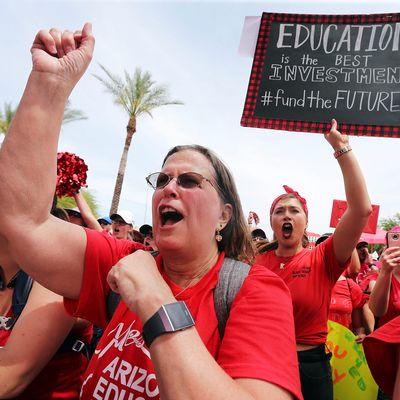In a significant display of collective action, thousands of teachers in Arizona and Colorado staged walkouts in 2018 to protest the chronic underfunding of public education. The strikes highlighted growing frustration among educators over inadequate salaries, overcrowded classrooms, and deteriorating school conditions, bringing renewed attention to the struggles facing state education systems. As the walkouts disrupted school schedules across both states, they also ignited broader debates about government spending priorities and the future of public education in the American West.
Teachers in Arizona and Colorado Protest Over Budget Cuts
The recent walkouts by educators in Arizona and Colorado mark a significant escalation in the ongoing battle over education funding in the Western United States. Teachers have staged coordinated protests, demanding increased budget allocations for schools, better pay, and improved classroom resources. Their actions come in response to years of stagnant or reduced state funding that many argue undermines the quality of education and affects student performance. Demonstrators emphasized the need for legislative action, urging state governments to prioritize education in upcoming fiscal plans.
Key demands from the protesting teachers include:
- At least a 20% raise in teacher salaries over the next two years
- Increased funding for classroom supplies and technology upgrades
- Reduction in class sizes to promote better student engagement
- Expanded support services for special education students
| State | Average Teacher Salary (2018) | Requested Raise (%) | Budget Cut Impact |
|---|---|---|---|
| Arizona | $47,500 | 20% | Large class sizes, outdated materials |
| Colorado | $50,200 | 18% | Reduced support staff, limited supplies |
Impact of Walkouts on Local School Districts and Student Learning
The recent wave of teacher walkouts has caused significant disruptions across various school districts in Arizona and Colorado. Many districts faced immediate closures, resulting in lost instructional time and forcing administrators to scramble for alternative arrangements. This upheaval not only interrupted daily routines but also strained resources, as substitute teachers were in short supply and extracurricular programs were postponed or canceled. The impact was felt unevenly, with underfunded and rural districts facing the steepest challenges in maintaining basic educational services.
Beyond the logistical issues, the walkouts have brought wider concerns about student learning outcomes to the forefront. Educators and experts highlighted several lasting effects, including:
- Increased learning gaps – Prolonged absences disproportionately affect students already at risk of falling behind.
- Decreased morale – Both students and teachers experience heightened stress and anxiety amid uncertainty.
- Parental challenges – Working families grappled with childcare disruptions and concerns over academic progress.
- Community polarization – Debates over funding priorities intensified tensions among local stakeholders.
| District | Days Closed | Estimated Instructional Hours Lost | Student Population |
|---|---|---|---|
| Phoenix Union High | 5 | 30 | 35,000 |
| Denver Public Schools | 4 | 24 | 92,000 |
| Tucson Unified | 3 | 18 | 45,000 |
State Lawmakers Respond with Proposed Education Funding Reforms
In response to widespread teacher strikes in Arizona and Colorado, state lawmakers have introduced a series of bold reforms aimed at addressing chronic underfunding in public education. Key proposals include increased budget allocations for K-12 schools, expansion of teacher salary schedules, and enhanced funding for classroom supplies and student support services. Legislators also emphasized the need for greater transparency in how education funds are distributed, seeking to ensure resources directly benefit schools and educators.
These proposed reforms outline a comprehensive strategy to tackle decades of fiscal challenges. The following table summarizes key components of the lawmakers’ plan:
| Reform Area | Proposed Change | Expected Impact |
|---|---|---|
| Teacher Salaries | 10-15% pay raise over 3 years | Improve retention & recruitment |
| Classroom Supplies | Dedicated budget for materials | Reduce out-of-pocket expenses |
| Student Support | Increase counselors & social workers | Address mental health & well-being |
| Funding Transparency | Public dashboard for expenditures | Enhanced accountability |
While these initiatives have garnered bipartisan attention, education advocates remain vigilant. Teacher unions and community groups have called for swift legislative action, emphasizing that meaningful reform must extend beyond temporary fixes to ensure long-term sustainability of public school systems.
Community Support and Calls for Increased Teacher Salaries
As teachers in Arizona and Colorado staged their walkouts, community members voiced strong support for their demands, emphasizing the critical need for increased investment in education. Parents, students, and local organizations rallied alongside educators, underscoring the hardships faced due to stagnant wages and underfunded schools. Many argued that boosting teacher salaries is essential not only to retain talent but also to ensure a quality learning environment for future generations. These calls resonated in school board meetings and public forums, with advocates pledging to sustain pressure on state legislatures.
Key community concerns include:
- Low teacher pay compared to national averages
- Overcrowded classrooms and insufficient resources
- Impact of budget cuts on extracurricular programs
- Teacher burnout and high turnover rates
| State | Average Teacher Salary (2018) | Student-to-Teacher Ratio | Recent Education Funding Changes |
|---|---|---|---|
| Arizona | $47,587 | 23:1 | -3% cut |
| Colorado | $53,862 | 17:1 | +2% increase |
Key Takeaways
As teachers in Arizona and Colorado continue to press for increased education funding, their walkouts underscore a growing national debate over the allocation of resources to public schools. The strikes highlight the challenges educators face amid budget constraints, and signal ongoing tensions between policymakers and those on the front lines of the classroom. With state governments grappling with competing priorities, the resolution of these protests will likely have significant implications for the future of public education in the region.







